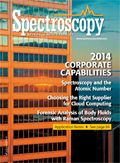Reducing Background in Surface Enhanced Raman Scattering Measurements
Raster orbital scanning (ROS) is a technique that dramatically increases the signal-to-noise ratio of Raman measurements made from target materials dispersed on surface enhanced Raman scattering (SERS) substrates.
Raster orbital scanning (ROS) is a technique that dramatically increases the signal-to-noise ratio of Raman measurements made from target materials dispersed on surface enhanced Raman scattering (SERS) substrates. For SERS substrates, rastering a laser beam across the sample decreases the background and samples many more Raman-active compounds compared to traditional static-beam techniques. The lower average power created by rastering the beam with ROS dilutes the laser power over a larger sample area. This lower average power reduces the risk of damaging the substrate, which often increases the background of the Raman spectrum.
A key challenge in acquiring high quality Raman data is reducing the background component of the spectrum, which can obscure peaks and make sample identification difficult. When analyzing SERS samples, be aware that the target material likely will be dispersed non-uniformly on the substrate. As a result, the static, tightly-focused laser spot used in traditional Raman sampling will often poorly overlap the Raman-active material and measure mostly background substrate. Also, a static laser beam can cause localized heating and damage to the SERS substrate, further increasing the background of the spectrum. ROS sampling found in Ocean Optics IDRaman reader and IDRaman mini products overcomes these challenges and improves SERS measurements.
ROS Sampling of SERS Substrates
In Figure 1, Raman shift versus wavenumber is shown for a SERS-active nanoparticle membrane tagged with 2-mercaptopyridine-N-oxide measured at 4 mW of laser power. The benefit of ROS sampling is demonstrated when the spectrum measured with traditional Raman sampling (emulated by turning ROS sampling off) is compared to the spectrum measured with ROS sampling. When raster scanning is enabled, the background (represented by the hashed line in the ROS off example) is much lower and peaks are more clearly resolved. This allows simpler and more confident identification of the target material.

Figure 1: A SERS sample measured at 4 mW of laser power with and without ROS sampling. ROS reduces the background component of the spectrum by collecting more data from the Raman-active hotspots relative to the background. The elevated background of a traditional, static laser beam sampling method is illustrated by the hashed line.
Furthermore, the effect of localized heating damage on SERS substrates is demonstrated in Figure 1 via the hashed, horizontal line on the y-axis. When ROS is not used, the background increases substantially. The constant movement of the laser spot with ROS turned on (lower spectrum) minimizes sample damage caused by localized heating from a static, focused laser spot. Therefore, ROS enables the use of higher laser power without degrading the quality of the Raman measurement.
Conclusions
As shown in this application note, the measurement of SERS samples can be greatly improved with the use of ROS. ROS reduces the background component of SERS spectra and helps to reveal features previously hidden in the high background of SERS substrate measurements. In addition, ROS samples a larger area and facilitates the use of less expensive, less homogeneous SERS substrates with the same enhancement of Raman activity. Lastly, ROS enables the use of higher laser power without the risk of damaging the SERS substrates, increasing the signal enhancement realized by the SERS technique.

Ocean Optics
830 Douglas Avenue, Dunedin, FL 34698
tel. +1(727) 733-2447, fax: +1(727) 733-3962
Website: www.OceanOptics.com

Thermo Fisher Scientists Highlight the Latest Advances in Process Monitoring with Raman Spectroscopy
April 1st 2025In this exclusive Spectroscopy interview, John Richmond and Tom Dearing of Thermo Fisher Scientific discuss the company’s Raman technology and the latest trends for process monitoring across various applications.
A Seamless Trace Elemental Analysis Prescription for Quality Pharmaceuticals
March 31st 2025Quality assurance and quality control (QA/QC) are essential in pharmaceutical manufacturing to ensure compliance with standards like United States Pharmacopoeia <232> and ICH Q3D, as well as FDA regulations. Reliable and user-friendly testing solutions help QA/QC labs deliver precise trace elemental analyses while meeting throughput demands and data security requirements.